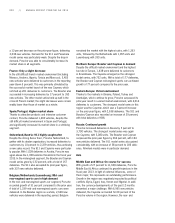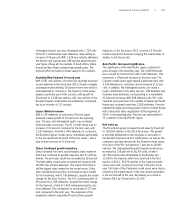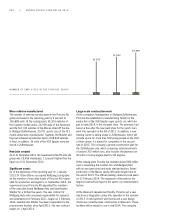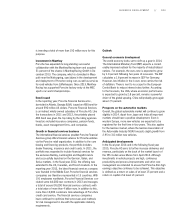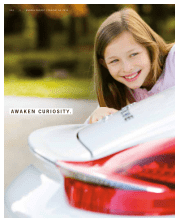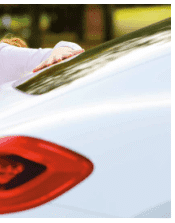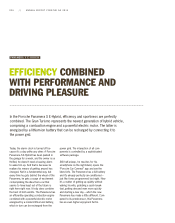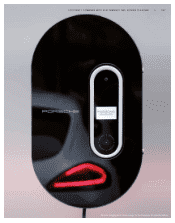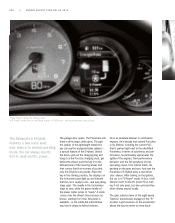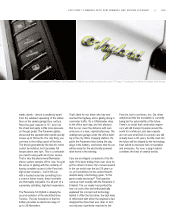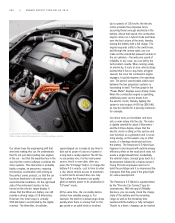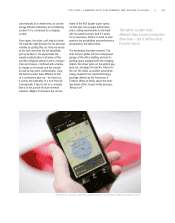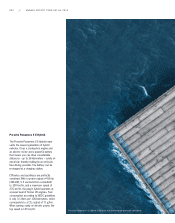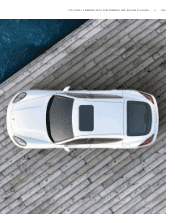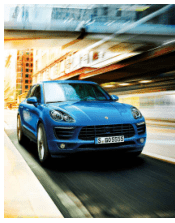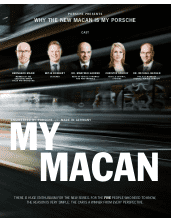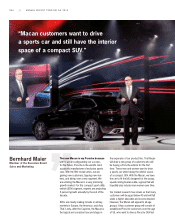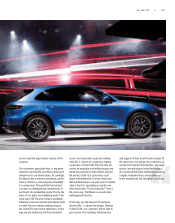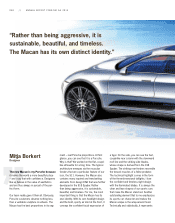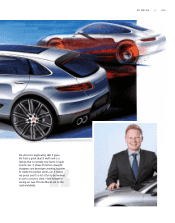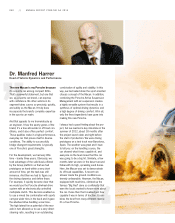Porsche 2013 Annual Report Download - page 32
Download and view the complete annual report
Please find page 32 of the 2013 Porsche annual report below. You can navigate through the pages in the report by either clicking on the pages listed below, or by using the keyword search tool below to find specific information within the annual report.
030 // ANNUAL REPORT PORSCHE AG 2013
Our driver loves the engineering skill that
went into making this car. He understands
that it’s not just about putting two engines
in the car – but that the expertise lies in the
way that the control software combines the
drive systems. This interaction is probably
highly complex, he presumes, requiring
tremendous coordination until arriving at
the perfect series product, so that the car
functions flawlessly in all day-to-day and
environmental conditions. On the right-hand
side of the instrument cluster, he has
turned on the electric range display. It
shows that the lithium-ion battery can still
provide a driving range of 18 kilometers.
However, the total range is actually
658 kilometers as indicated by the digital
read-out. The three-liter, six-cylinder,
Up to speeds of 135 km/hr, the electric
motor provides the propulsive force,
assuming there’s enough electricity in the
battery. Above that speed, the combustion
engine comes on in hybrid mode and takes
over the lion’s share of the work, thereby
leaving the battery with a full charge. The
engine responds softly to the switch-over,
and through the serene quiet, you can
make out the muted but pleasant rumble of
the six cylinders – the welcome sound of
reliability. In any case, you can tell by the
tachometer’s needle. When running solely
on electricity, it rests at zero, almost disap-
pointed that it has to stay there at higher
speeds; but once the combustion engine
engages, it quickly registers the operating
rpm. The almost unnoticeable switch-over
between the two propulsion systems is
fascinating in itself. The flow graph in the
“Power Meter” displays every driving mode.
When the combustion engine is operating,
additional power can be drawn from
the electric motor, thereby tapping the
system’s total output of 416 hp (306 kW),
as may be needed for a passing maneuver,
for example.
Our driver turns on the blinker and turns
onto a main artery into the city. The route
is slightly downhill for about 5 kilometers –
and the E-Drive display shows that the
electric motor is idling on this section and
now functions as a generator and is recov-
ering energy, as the experts say; in other
words, it is feeding electricity back into
the battery. The Panamera S E-Hybrid just
happens to be blessed with optimal energy
efficiency when on the road and it does not
waste a single kilowatt-hour. Incidentally,
the vehicle’s basic concept goes back to a
development initiated by a trainee project.
Young Porsche employees went on to
build the prototype and it so impressed the
managers that they gave it the green light
for series development.
The Panamera S E-Hybrid is supplemented
by the “Porsche Car Connect” app for
smartphones. With the app’s E-Mobility
Services, you can easily check the charge
state of the battery and the remaining
range as well as the remaining time
needed until the battery is fully recharged.
Thanks to a timer, charging can be started
supercharged car is ready at any time to
dish out its power if a burst of speed or
a long haul is really required. The V6 has
no secondary role; it is the main power
source. And it is even able, after you
press the “E-Charge” button, to charge the
battery if it is empty – just in time to enter
a city, where vehicle access to downtown
is restricted to emission-free cars only.
That’s when the Panamera can quietly
glide on battery power to its destination in
“E-Power” mode.
At the same time, the car visibly demon-
strates how valuable energy is. For
example, the electric residual range drops
quickly when there is a heavy foot on the
gas pedal or an uphill climb is involved.
Combustion engine plus electrical motor:
Thick cables reveal the presence of a high-voltage system.


